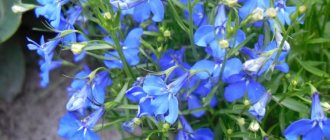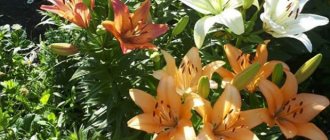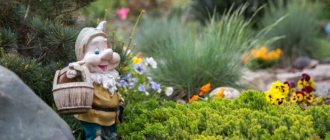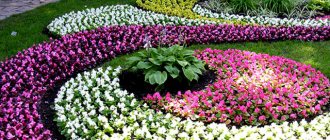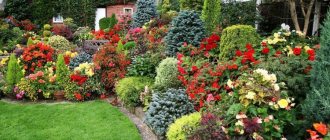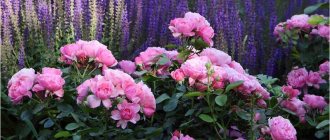Benefits of Plants
Flowerbeds where dahlias grow always look great. Among dahlias, there are a huge number of different species, differing in shape, color and other parameters. This variety is beneficially used by experienced gardeners when designing flower beds. In the latter, you can harmoniously combine different terry varieties. In addition, there are semi-double species that look no worse.
Particularly interesting are the flower beds, which contain specimens with inflorescences shaped like a disk with several reeds. Much attention is paid to pompom dahlias, which have the shape of a ball.
Dahlias are painted in almost all colors of the palette, which allows you to brightly decorate your flower beds. Pastel shades are particularly attractive when decorating flower beds. The peculiarity of dahlias is their extreme attractiveness, both alone and in pairs with other flowers. There are various schemes that, when decorating a flower bed, suggest focusing on a specific variety. This option looks advantageous in the central part of the flower garden, and its outskirts are decorated with shorter plants.
Unlike other flowers, dahlias do not require special care conditions. Like most plants, they need warm weather, direct sunlight and proper moderate feeding. Otherwise, the flowers become weak and do not produce abundant blooms.
Species diversity
The color and shape of the flowers are no less varied. Among the colors of dahlias there are all tones except blue and black, and the flowers themselves can be either single-colored or variegated.
As for the shape, dahlias can be simple, semi-double, or double:
- Simple inflorescences are characteristic of the so-called minions, in which a single-row wreath of bright, richly colored petals is gathered around a yellow center.
- Semi-double inflorescences are found in elegant, vulnerable and very graceful beauties belonging to varieties of the collared, anemone-shaped and peony-shaped dahlia groups.
- The most widespread are terry dahlias - large-flowered and spherical.
The double-type dahlia community includes a large number of subspecies, including the famous cactus dahlias, small cactus dahlias, pompom dahlias and spherical dahlias. The most exotic variety of dahlias are chrysanthemum-shaped ones, which are also called starfish or giraffe dahlias.
Main varieties with photos
The classification of these plants is related to the structure, as well as the shape of the flower itself. At the moment, there are 12 classes of dahlias. However, new classes are gradually appearing and this is associated with the formation of new varieties. Below are the varieties that are most popular:
Simple They have one row of petals, the diameter of the flowers is 10 centimeters. The height of the bush, as a rule, does not exceed 45–60 centimeters. The main varieties are: Princess Marie Jose - pink, Yellow Hammer - yellow, and Orangeade - orange-red. Anemoneaceae
There are 1 or more rows of marginal petals. In the middle they are tubular and elongated. The diameter of the inflorescences does not exceed 10 centimeters, and the height of the bush can be 60–90 centimeters. The main varieties are Lucy with a lilac-yellow color, bronze Vera Higgins and Comet with red color.
Collar
The diameter of the flowers is approximately 10 centimeters, and the height of the bush can reach 75–120 centimeters. There is 1 marginal outer row of petals; directly along its top there is another row of twisted and short petals of a different color, which is similar in appearance to the collar. The main varieties are gold and scarlet La Gioconda, Chimborazo cream and reddish, Claire de Luna cream and yellowish.
Peony-shaped
The diameter of the flowers is 12–15 centimeters. The marginal flat petals are arranged in 2 or more rows, and tubular petals are located in the central part. The height of the bush is 75–120 centimeters. Main varieties: crimson-red Symphonia and lilac Fascination.
Dahlias Cheerful guys - combination with other flowers in flower beds
Bright, multi-colored decorative dahlias are a real decoration for flower beds and compositions. Among the many varieties of garden flowers, annual dahlias “funny guys” occupy a special place, thanks to a number of valuable advantages. For example, drought resistance allows them to be grown in regions with intermittent water supplies and in the absence of frequent rains. Even novice gardeners can grow low-maintenance flowers. The biggest fans of annual flowers can breed them at home, for example, by planting them in flower beds. Designers use bright and cheerful dahlia bushes to form flower beds, edgings or borders. If the garden plot is located on a slope, it can be planted with a continuous array of dahlias. A friendly family will look great as an independent decor or in combination with other flowers in flower beds: petunias, asters, marigolds.
You just have to adhere to the rule that other flowers should be less bright, preferably the same shade. The combination of bright dahlias with blue flowers, such as delphinium or sage, looks very original and unusual.
Problems during cultivation
Dahlias are susceptible to disease and pest attacks.
Gray rot
The disease begins with the appearance of gray spots on the leaves. Then the leaves turn brown and dry out. Unopened buds fall off. Affected leaves are torn off and burned.
Fusarium
The plant's stem rots at the surface of the earth at the junction with the root system. The only control measure is prevention. It is necessary to ensure air permeability of the soil (loosening, mulching), and to prevent stagnation of moisture at the roots.
Aphid
Signs of aphid damage are sharply yellowed leaves twisted into a tube. Parts of the plant affected by aphids are cut off and burned. The bush is treated with the drug "Actellik" or decoctions of tobacco, garlic, and soap solution.
Slugs and bedbugs
They are less common. Signs: holes in the leaves. They are fought with the drugs “Iskra” and karbofos. By choosing annual dahlias, you can get an excellent result with a minimum of cost, a real celebration of colors and variety of shapes.
Currently reading:
- Choosing cucumbers for open ground according to your preferences
- Planting, care and beneficial properties of Savoy cabbage
- Planting to decorate the site with three types of coniferous trees
- How to grow Chinese cabbage in open ground
Share the news on social networks
About the author: Vladimir Petrovich Efremov
Chief agronomist of the limited liability company “Association of Peasant (Farm) Farms “Kuznetsovskaya””, Ilovlinsky district of the Volgograd region.
Where to plant
“The best place for dahlias in the country will be the south side of the house (and they will need to be planted there closer to the wall), as well as near groups of taller plants, also on the side with the most light.”
Flowers of this type are loved by:
1. Light.
2. Warmth.
Dahlias love bright, well-lit areas
Lowlands and hills blown by seven winds are not suitable for them. In the first case, they will die from excess moisture and accumulation of cold air, and in the second case, they will not survive due to drafts. However, this does not mean that the plant should be hidden in a greenhouse or planted in thickets of bushes and trees. It needs a regular supply of fresh air. Based on this, the best place for dahlias in the dacha will be the south side of the house (and they will need to be planted there closer to the wall), as well as near groups of taller plants, also on the most illuminated side.
It is preferable to plant dahlias on the south side of the dacha
Top dressing
If the plant was initially planted in a nutrient medium, no additional feeding is required. If the soil is poor, it can be fertilized with organic matter in the fall. During the growing season, it is recommended to feed plants with complex fertilizers - this way they will bloom better . After adding food, the bushes need to be watered.
During flowering, the plant can be fed with phosphorus and potassium.
What to plant next to peonies
You will also most often see large sun-loving peony bushes in the garden in solitaire plantings due to their significant size and decorative value. In addition, the peony is a true individualist, demanding of resources, and with a high degree of probability it will shade and survive almost any neighbors, especially if they are carelessly planted at a distance of closer than one meter (this even applies to trees!).
If you have enough space in your flower garden, you can plant any later-blooming annuals that love the sun and can easily tolerate moderate drought, away from the peonies. Against the background of lush green, but already faded peony bushes, they will look like bright accents.
If we consider crops that are decorative not with flowers, but with leaves, peonies combine well with hostas and soft mantle.
In tiered plantings of experienced flower growers, the peony is always the top tier, which is either adjacent to a vertical surface (fence, wall) behind all the other vegetation, or is the center in circular plantings.
From other combinations, we can recall that the same nasturtiums will become good “medicinal” neighbors for peonies, and lilies of the valley will become a depressing factor.
- Peonies - famous and not so
There are approximately 10,000 varieties of peonies in the world, and all of them, with a few exceptions, are bred from a single wild species - peony lactiflora. Which ones are the most interesting?
Application
The medicinal properties of dahlias allow them to be classified as medicinal plants. Decoctions of these flowers normalize metabolic processes and are beneficial for the cardiovascular system. Tincture of rhizomes is used as a prophylactic against diabetes. Fresh leaves are applied to the skin to treat acne. The rhizomes are used in crushed form as a mask for aging facial skin. Powder from the tubers is rubbed into the base of the hair follicles to strengthen the hair.
Low-growing varieties are used for borders, flowerpots, and balcony boxes. Most varieties are used in free compositions or group plantings. And especially spectacular, profusely flowering ones - in single plantings. Varieties with long, strong peduncles are used for cutting and stand well in water for more than a week.
Dahlias have always been loved by our flower growers. Some of them have entire collections - their flower beds attract attention with the abundance of blooming dahlias. The abundance of planting material on store shelves, sufficient unpretentiousness, and lush flowering place the dahlia among the most popular plants in our areas.
Among the countless varieties and hybrids of sweet peppers, there are those, such as the Ramiro pepper, whose popularity is literally worldwide. And if most vegetables on supermarket shelves are nameless, and it is almost impossible to find out about their variety, then the name of this pepper “Ramiro” will certainly be on the packaging. And, as my experience has shown, this pepper is worth letting other gardeners know about it. In connection with which this article was written.
Autumn is the most mushroom time. It is no longer hot, and heavy dew falls in the mornings. Since the earth is still warm, and foliage has already attacked from above, creating a completely special microclimate in the ground layer, the mushrooms are very comfortable. Mushroom pickers are also comfortable at this time, especially in the mornings when it is cooler. It's time for both to meet. And, if you haven’t introduced yourself to each other, get to know each other. In this article I will introduce you to exotic, little-known and not always edible mushrooms that look like coral.
If you are a busy person, but at the same time not devoid of romance, if you have your own plot and are endowed with aesthetic taste, then explore the opportunity to purchase this wonderful ornamental shrub - karyopteris, or Nutwing. He is also “wing-hazel”, “blue fog” and “blue beard”. It truly fully combines unpretentiousness and beauty. Karyopteris reaches its peak of decorativeness in late summer and autumn. It is at this time that it blooms.
Pepper ajvar - vegetable caviar or thick vegetable sauce made from bell peppers and eggplants. The peppers for this recipe are baked for quite a long time, then they are also stewed. Onions, tomatoes, and eggplants are added to ajvar. To store eggs for the winter, they are sterilized. This Balkan recipe is not for those who like to make preparations quickly; undercooked and underbaked ajvar is not about it. In general, we approach the matter in detail. For the sauce, we choose the ripest and meatiest vegetables on the market.
Despite the simple names (“sticky” or “indoor maple”) and the status of a modern substitute for indoor hibiscus, abutilons are far from the simplest plants. They grow well, bloom profusely and provide a healthy look of greenery only in optimal conditions. On thin leaves, any deviations from comfortable lighting or temperatures and disturbances in care quickly appear. To reveal the beauty of abutilons in rooms, it is worth finding the ideal place for them.
Zucchini fritters with Parmesan and mushrooms - a delicious recipe with photos of available products. Ordinary zucchini pancakes can be easily turned into a non-boring dish by adding a few savory ingredients to the dough. During the squash season, pamper your family with vegetable pancakes with wild mushrooms; it is not only very tasty, but also filling. Zucchini is a universal vegetable, it is suitable for stuffing, for preparations, for main courses, and even for sweets there are delicious recipes - compotes and jam are made from zucchini.
The idea of growing vegetables on the grass, under the grass and in the grass is scary at first, until you become imbued with the naturalness of the process: in nature, this is exactly how everything happens. With the obligatory participation of all soil living creatures: from bacteria and fungi to moles and toads. Each of them contributes. Traditional tillage with digging, loosening, fertilizing, and fighting all those we consider pests destroys the biocenoses that have been created over centuries. In addition, it requires a lot of labor and resources.
What to do instead of a lawn? So that all this beauty does not turn yellow, does not get sick and at the same time looks like a lawn... I hope that the smart and quick-witted reader is already smiling. After all, the answer suggests itself - if you do nothing, nothing will happen. Of course, there are several solutions that can be used, and with their help, you can reduce the area of the lawn, and therefore reduce the labor intensity of caring for it. I propose to consider alternative options and discuss their pros and cons.
Tomato sauce with onions and sweet peppers - thick, aromatic, with pieces of vegetables. The sauce cooks quickly and is thick because this recipe contains pectin. Make such preparations at the end of summer or autumn, when the vegetables have ripened in the sun in the garden beds. Bright, red tomatoes will make equally bright homemade ketchup. This sauce is a ready-made dressing for spaghetti, and you can also simply spread it on bread - very tasty. For better preservation, you can add a little vinegar.
This year I often observed a picture: among the luxurious green crown of trees and shrubs, here and there, like candles, the bleached tops of shoots “burn.” This is chlorosis. Most of us know about chlorosis from school biology lessons. I remember that this is a lack of iron... But chlorosis is an ambiguous concept. And lightening of foliage does not always mean a lack of iron. What is chlorosis, what our plants lack during chlorosis and how to help them, we will tell you in the article.
Korean vegetables for the winter - delicious Korean salad with tomatoes and cucumbers. The salad is sweet and sour, spicy and slightly spicy because it is prepared with Korean carrot seasoning. Be sure to prepare a few jars for the winter; in cold winter, this healthy and aromatic snack will come in handy. You can use overripe cucumbers for the recipe; it is better to harvest vegetables in late summer or early autumn, when they are ripe in the open ground under the sun.
Autumn for me means dahlias. Mine begin to bloom as early as June, and all summer the neighbors peek at me over the fence, reminding them that I promised them a few tubers or seeds by the fall. In September, a tart note appears in the aroma of these flowers, hinting at the approaching cold. This means it’s time to start preparing the plants for the long, cold winter. In this article I will share my secrets of autumn care for perennial dahlias and preparing them for winter storage.
To date, through the efforts of breeders, according to various sources, from seven to ten thousand (!) varieties of cultivated apple trees have been bred. But despite their enormous diversity, in private gardens, as a rule, only a couple of popular and beloved varieties grow. Apple trees are large trees with a spreading crown, and you cannot grow many of them in one area. What if you try to grow columnar varieties of this crop? In this article I will tell you exactly about these varieties of apple trees.
Pinjur - Balkan-style eggplant caviar with sweet peppers, onions and tomatoes. A distinctive feature of the dish is that the eggplants and peppers are first baked, then peeled and simmered for a long time in a Dutch oven or in a thick-bottomed pan, adding the rest of the vegetables specified in the recipe. The caviar turns out to be very thick, with a bright, rich taste. In my opinion, this cooking method is the best known. Although it is more troublesome, the result compensates for the labor costs.
During the flowering period, dahlias transform the summer garden into a colorful fairy tale, filled with bright scenes and sunlight. The variety of these flowers is such that they satisfy the refined tastes of even the most demanding gardeners. Despite the wide palette of colors and extravagance of flowers, there are still some difficulties in the skillful use of dahlias in garden design.
Various forms of dahlias
Sunflowers are good companions for dahlias, not only because of the intense color of the inflorescences, but also because of their size. Sunflowers protect the thin stems of dahlias from wind damage. And it is not necessary to plant only annual sunflowers. Even though perennial helianthus are not so tall, they are also good protection from the winds for our dahlias.
In a flower garden with dahlias, the rule often applies: less is more. Instead of various flowering plants that will compete with dahlias in beauty and variety of colors, you can use only two or maximum three varieties of dahlias, diluting them with filigree ornamental cereal grasses. Perhaps the ideal option is millet, which gives the flower garden a beautiful golden-yellow or red-brown hue that harmonizes perfectly with the fiery red dahlias. Tall cereal grasses, such as Chinese, are excellent as a backdrop.
When choosing two or three varieties for a dahlia flower garden, you should take into account the size and shape of the inflorescences. So, spherical and pompom dahlias, or cactus-shaped dahlias with deer-antler shaped dahlias, go well together. A composition of dahlias with simple and lacy inflorescences looks impressive.
An important aspect when composing a composition is not only the size and shape, but also the color of the inflorescences. If you choose a multi-colored variety from one class of dahlias, then dahlias from another class should be monochromatic. Using different varieties of dahlias of the same class, you can create a smooth transition of shades, which gives a special charm to the flower garden, or you can limit yourself to one color, choosing varieties with different shapes of inflorescences.
Dahlias and annuals
Perhaps the most popular composition is the combination of dahlias with annual flowers, since when digging dahlias in late autumn, you do not need to take into account their annual companions. Thus, good flowerbed partners for dahlias can be double and simple zinnias (Zinnia elegans), cosmos (Cosmos bipinnatus), annual asters (Callistephus chinensis), and lobelias (Lobelia fulgens) that match them in color and shape.
Dahlias look great in the company of perennials and annuals. A composition of small-flowered dahlias of yellow or orange color in the friendly company of Helenium, perennial sunflower (Helianthus microcephalus), Pennisetum setaceum, and marigolds (Tagetes) always attracts attention. The morning glory sweet potato with dark foliage gives a beautiful contrast to the composition. Depending on the size of the flower garden, dark-leaved varieties of sedum, heuchera, and rudbeckia are also excellent.
If you love the elegance of the cool, fresh colors of summer, then an arrangement of white and purple dahlias combined with various varieties of paniculate phlox in similar shades will suit you. The composition is completed by white or purple asters, as well as feathery feather grass.
If you want to create a flower garden full of expression, fire and passion, then your colors are flashy red and cool white! And here it is very important to choose the right red tones of dahlias and their companions so that they suit each other and are not very different from each other. For red dahlias from white companions, the following are excellent: white toadflax (Linaria purpurea “Alba”), virgin veronicastrum (Veronicastrum virginicum “Diana”), white phlox, white varieties of autumn anemones, cape grass (Aconitum napellus “Schneewittchen”).
For red companions, you can choose, for example, (“Gardenview Red” and “Sqaw”) or Lychnis chalcedonia.
Red dahlias in the company of geranium and Waller's balsam
Good to know
A dahlia flower garden needs care even during the flowering period. To prevent the flying petals from sticking to the green leaves, it is necessary to cut off the inflorescences at the first signs of wilting. Large dahlia bushes need to be tied to a support so that the wind does not break their shoots with heavy inflorescences. A boxwood border approximately 50 cm high can serve as a beautiful alternative. It will not only hide the inconspicuous stems of dahlias, but will also serve as a good support for them.
Translation: Lesya V. especially for the gardening internet portal
Many gardeners grow this amazing flower in their flower beds. If you look at different photos of dahlia, you will notice that the plant has a wide range of colors and a variety of shapes. These flowers can become a decoration for any garden plot. To get lush bushes, you should know how to grow them.
The dahlia, which was brought to European countries from Mexico back in the 17th century, looks bright in flower beds. The name of the plant was given in honor of the famous ethnographer Johann Georgi. The German scientist worked and lived in St. Petersburg.
The huge variety of forms of this flower is amazing. It is used for borders and used as single plants. Elegant flowers in flower beds look amazing.
Care
Growing shoots must be tied to pegs in a timely manner so that they are not broken by the wind. Keep tree trunk circles clean: pull out weeds throughout the season, loosen the soil until buds appear. When dahlias bloom, it is better to sprinkle the ground around the bushes with mulch (peat, humus). Mulch makes maintenance easier: it retains moisture and inhibits the growth of weeds. During the season you need to hill up the bushes twice. The first time was a young bush, the second time in early September.
We water correctly
Everyone knows about the unpretentiousness of a flower, but the decorativeness of a flower bed largely depends on how to care for the dahlias on it. Watering is needed frequently - twice a week. Water generously. In the hot summer, use mulch.
Weekly care for dahlias includes disease prevention. In order to prevent diseases, copper sulfate can be added to water for irrigation; for this, 1 teaspoon of powder is poured into a bucket of water. Water with water and copper sulfate once every 10 days.
Annual dahlias - what is their difference from perennials
Annual dahlias variety Dandy
Annual dahlias, compared to perennial varieties, are more unpretentious in cultivation and care. There is no need to waste time and effort preparing tubers for planting. To get flowering plants, it is enough to sow seeds directly into the ground or grow seedlings.
Annual dahlias bloom longer - from mid-summer until autumn frosts. They endure unfavorable weather conditions and are less likely to be affected by diseases and pests.
It is not necessary to dig up the tubers in the fall and store them in the winter. The next season can also be started by sowing seeds.
Dahlias for a bouquet for September 1
Rules and traditions, fashion and tastes change. Asters were once popular, today dahlias are no longer a rarity or a curiosity in school bouquets. Flowers of exceptional beauty are great for bouquets and prolong their beauty, since the first frosts are traditional before September 1st. True, when cut, their lifespan is short, and the heavy “caps” of large inflorescences often droop and can break. To prolong the life of dahlias, florists recommend scorching a fresh cut of the stem with fire so that the released juice does not interfere with the flow of water. Photo of bouquets for the teacher made from dahlias plucked from a flowerbed
How to collect seeds yourself
Annual double dahlias variety Vasilisa
To grow annual dahlias, not only purchased seeds are used. They can be collected from faded plants in the garden. High-quality plants are selected in advance; the first blooming flowers are best suited for this.
Faded inflorescences are not cut off, but left on the stem . After the petals fall off, a green box with seeds remains. They ripen within 1-1.5 months. The box changes color to dark beige. If it is not cut in time, it may open and the seeds will fall to the ground. To prevent this from happening, the ripening box is tied with gauze.
Harvest seeds in dry, warm weather. They are dried indoors at room temperature for several days, and then placed in paper bags or fabric bags and put away for storage.
If the weather is rainy during ripening, the seed pods are cut off, brought into a room with a temperature of 20-25°C, hung with their heads down and allowed to ripen in room conditions. Seed germination is maintained for 4 years.
Purchased
Those who are thinking about how to plant dahlias for the first time must first purchase planting material. It must correspond to the idea of landscape design, which means it must correspond to the entire garden concept.
It is better to purchase dahlias for planting in specialty stores. When choosing, carefully inspect the tuber. It must be elastic, strong and of sufficient weight. Wrinkled, dry, lungs are not suitable, most likely they are already dead.
Features of reproduction
Dahlias reproduce by seeds and tubers.
Propagation by seeds
Many gardeners are stopped when growing Dahlia by the fact that the tubers of this flower cannot overwinter in the ground, and in order to preserve them in winter, certain conditions must be observed. In this case, you can use seeds to plant dahlias. These will be annual plants. Non-double (simple) or collared dahlias are mainly propagated by seeds.
Planting seeds can be done in the spring directly into the ground. But then Dahlia will delight you with beautiful flowering only at the end of summer. In order for it to bloom from the beginning of summer, it is necessary to grow flowers through seedlings.
For seedlings, seeds are sown in April. Seeds are placed in a prepared container with sand and covered with a sand layer on top. Having moistened well, cover the container with film or a transparent lid and place it in a warm place with a temperature of 25-27 degrees. After the third leaf appears on the seedlings, the seedlings are planted in separate cups, where they grow until planted in the prepared area.
Propagation by tubers
The best results in breeding Dahlia can be achieved if tubers are used for planting. They can be purchased at the market from flower growers or in special flower shops, or you can use old ones that you grew.
If you purchase new tubers, you do not need to do this in the fall or winter. It is better to purchase tubers in late spring, when they need to be planted in the ground. Healthy tubers should be strong and fleshy, preferably with small sprouts.
If you are going to use old tubers for planting next year, then first of all, they need to be properly preserved. To do this, you need to carefully dig up the plant, separate the tubers from the above-ground part of the plant and sprinkle them with sand and ash. The place where the tubers of this flower will be stored should be warm and draft-free. It is necessary to periodically inspect and moisten the tubers.
Soil preparation and planting
To get a good harvest, the soil must be properly prepared. The optimal composition for planting flowers should contain nutritious soil, sand and humus. You can buy ready-made soil at a flower shop, or you can collect it in a meadow, preferably in a place where clover and other herbs bloomed. The composition should contain 2 parts of soil and 1 part each of humus and sand. A few days before planting the plant, the soil should be disinfected with a warm solution of potassium permanganate, and for greater guarantee, it should be calcined in the oven for 2-3 hours.
General rules for forming a flower garden or flower bed
In landscape design, there are a lot of rules and secrets for creating a harmonious flower garden.
Here the requirements of the plants themselves must be taken into account - you need to try to select flowers with the same requirements for lighting, soil composition and frequency of watering, so as not to cause them discomfort during the process of growth and development.
Here it is important to take into account the size and shape of both the flowers themselves and the plant as a whole - so that they do not interfere with each other, for example, strongly shading or interfering with the root system of the “neighbor”.
Here it would be nice to know the timing of flowering - regardless of whether you are planning a flowerbed of continuous flowering, where some flowers would replace others, or an option with bright colors only for a certain period of time and lush greenery for the rest of the time period.
Here you need to remember that some plants can oppress others due to their size or active consumption of resources or, conversely, protect them from certain pests and help them actively develop.
This certainly touches on the issue of successful color combinations and avoiding both excessive, eye-straining variegation, and boring, boring options.
- How to correctly combine plants in a flowerbed by color
Don’t know how to combine colors in a flowerbed so as not to go to extremes - clumsy or plain? We'll tell you!
In addition to all this knowledge, it would be nice for a novice gardener to know that in landscape design there are entire schemes of the most successful plantings, each of which has its own rules of organization. For example, according to their location on the site, flower beds can be lateral, vertical or central;
Now let's talk in more detail about the most favorite garden flowers - what combines best with what?
What colors do dahlias go with in a flower bed? Luxurious dahlias
Residents of European countries such as Great Britain, Germany and even as “Northern” as Ireland find it much easier than us to grow dahlias. There is no need to dig up dahlia tubers for the winter; they are just covered with a thick layer of mulch in late autumn. That's all!
In our climate situation, such a number will not work.
Apparently, for this reason, beautiful dahlias are most often grown in beds, which is only suitable for growing cut flowers for bouquets. What if you try to grow dahlias in a flower garden, choosing suitable partners for them?
I am convinced that it will turn out great if you simultaneously comply with all the requirements of agricultural technology.
What to plant next to chrysanthemums
Light-loving chrysanthemums are among the most “non-capricious” neighbors and will get along well on the site with most ornamental crops.
So, they will be perfectly shaded by sage, coleus, sedum, ivy, garden grasses - against their background, the flowering of chrysanthemums will seem even brighter.
If you take beautifully flowering plants, then you can add both annuals and perennials to accompany the chrysanthemums in a multi-high tiered flower bed: dicentra, daisies, monarda, asters, marigolds, dahlias, snapdragons, delphinium, rudbeckia, vernonia, calendula, zinnias.
Of course, monoflower beds with multi-colored chrysanthemums of different varieties will look great - fortunately, this plant has plenty of shapes and shades, there is plenty to choose from.
- Chrysanthemums - how to grow a healthy plant?
We answer 3 main questions about chrysanthemums.
What to plant next to lilies
Like roses and peonies, lilies feel most comfortable in the garden “on their own.” Large, voluminous, noticeable... In addition, recently Asian and oriental hybrids of lilies have become especially popular, in which flowers are produced in large quantities, and the flowering period can last several months. What's not the ideal tapeworm?
Usually lilies in a flower garden are planted in peculiar “islands”, combining them by color or variety. A wonderful option would also be different varieties of lilies, planted in one group, but in two or three tiers.
If you absolutely want to combine this tall, regal flower with other plants in your garden, pay attention to low and medium-height perennials - for example, bergenia or peony.
You can go the unconventional route and choose companion plants like Echinacea or eryngium (eryngium) to accompany your lilies. Of course, here it will be important to “play” with the shades of these colors, so that instead of the expected exoticism you don’t end up with a tacky “something”. However, this applies to any flower combinations.
Lilies will also look good in company with hostas, since even their inflorescences are similar in shape (this is especially true for wavy, tall and swollen hostas). In addition to the fact that hostas will add shades of lush greenery to your flower garden, you can choose these plants so that they also bloom with lilies in turn.
- Types and groups of garden lilies - description and photo
Classification of lilies will help you decide on the choice of type and variety.
Use in garden design
Dahlias are most widely used in the design of flower beds and ridges. These plants are usually planted in groups; Combinations of different varieties are often used. Compositions from dahlias are quite difficult, because choosing a color scheme requires some effort, searching for the ideal combination of shapes and colors. The main mistake gardeners make is often garish combinations that are too harsh in tone selection. Separately planted dahlia bushes also look great.
For borders, ribbons and small ridges, it is customary to use low-growing varieties, because tall and sloping bushes can turn into an impassable barrier along paths or obscure other plants and corners of the garden, which they are intended to decorate.
Dahlias look great both in tubs and flower pots. It is better to make such mini-flower beds monogamous, without combining dahlias with other plants and place them in open areas, because on terraces and balconies dahlias may not receive enough sunlight.
